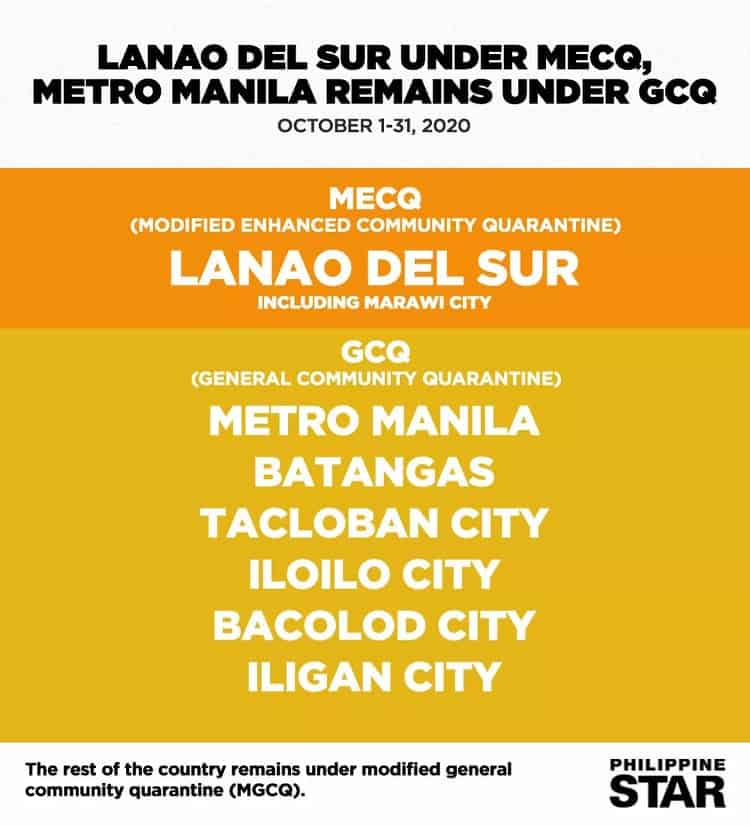
MANILA, Philippines — There will be no easing of quarantine restrictions in Metro Manila next month despite the government’s efforts to gradually reopen the pandemic-ravaged economy.
As approved by President Duterte and the Inter-Agency Task Force for the Management of Emerging Infectious Diseases (IATF), the National Capital Region will remain under general community quarantine or GCQ for the entire October. The NCR has been under GCQ since the second week of August.
Also under GCQ are Batangas province and the cities of Tacloban, Iloilo, Bacolod and Iligan. Except for Tacloban, the cities used to be under the stricter modified enhanced community quarantine or MECQ.
Lanao del Sur including Marawi City will remain under MECQ due to the rising number of COVID-19 infections. Lanao del Sur and Bacolod City were placed under MECQ from Sept. 8 to Sept. 30 to address the increasing number of infected persons.

The rest of the country will be under the most lenient modified general community quarantine or MGCQ.
Earlier yesterday, Navotas Mayor Toby Tiangco explained that Metro Manila “is not yet ready” to shift to MGCQ, as suggested by some business and medical groups.
“We should learn from the past, when the region was not yet ready for GCQ but was forced to do so and reverted to modified enhanced community quarantine,” Tiangco said.
Metropolitan Manila Development Authority general manager Jojo Garcia said the MMDA forwarded the proposal of the mayors, who comprise the Metro Manila Council (MMC), to the IATF.
He stressed the need to balance health and the economy and not to squander the gains from the GCQ by easing it.
“We want to maintain the curve. Our numbers are improving, so let us not waste it. Let us make changes gradually,” Garcia said.
The mayors have also decided to change their mindset of having to make a choice between health and economy.
“We need to live with this already. Between health and economy, we can no longer prioritize one over the other. It should be side by side,” Garcia said.
Metro Manila has been under GCQ since July 1, save for the 15-day return to a stricter quarantine status last August. Under GCQ, public transportation is allowed to operate under limited capacity and most industries are allowed to open.
Zamora, who had repeatedly cautioned against rushing a shift to modified GCQ, said the current quarantine status should remain for now to sustain the “sharp” decrease in COVID-19 cases in Metro Manila.
He maintained that local government responses were working, citing particularly the “trace, isolate, test and treat” approach and other measures enforced like localized lockdowns.
Improved critical care rates
According to Department of Health (DOH) figures, Metro Manila had 20,178 active cases, 2,623 deaths, and 137,995 recoveries as of Sunday – or a total of 160,796 confirmed COVID-19 cases.
For Health Undersecretary Leopoldo Vega, there should be significant improvement in critical care utilization rates in Metro Manila hospitals before the region’s quarantine status is relaxed.
Vega said any decision of the IATF on the quarantine status of Metro Manila should factor in various metrics formulated by the Bureau of Epidemiology of the DOH.
He said one of the parameters is the critical care utilization rates, which pertain to ICU beds, isolation beds, wards and mechanical ventilators assigned to COVID-19 patients.
Vega noted the utilization rate for ICU beds alone, for instance, is around 60 percent, indicating that “we are still moderate risk.”
“This must be brought down to below 60 percent or for the lower risk category. If we maintain it at 63 percent, then we will remain under GCQ so that restrictions can be implemented,” he added.
Vega also said the decongestion of hospitals in Metro Manila is not enough basis for the IATF to see a downgrading of GCQ to MGCQ.
Based on DOH data as of Sept. 26, the occupancy rate of ICU beds was 63 percent, while isolation beds have a 51 percent occupancy rate and 54 percent occupancy rate for ward beds.
He added this is why the DOH has been calling on private and public hospitals to continue to increase their allocations of beds for COVID-19 cases. – Alexis Romero, Marc Jayson Cayabyab, Sheila Crisostomo
#realestateblogph | #realestateblogphpropertynews | #REBPH
Article and Photo originally posted by The Philippine Star Global last September 29, 2020 12:00am and written by Edith Regalado, Neil Jayson Servallos .







More Stories
Vista Land Celebrates 50 Years with Sandiwa: An Event Honoring Leadership, Legacy, and the Filipino Dream of Homeownership
Vista Land Celebrates Love Month in Ilocos Region
Vista Land Bridges Cebuano Heritage and Progress with Valencia by Vista Estates